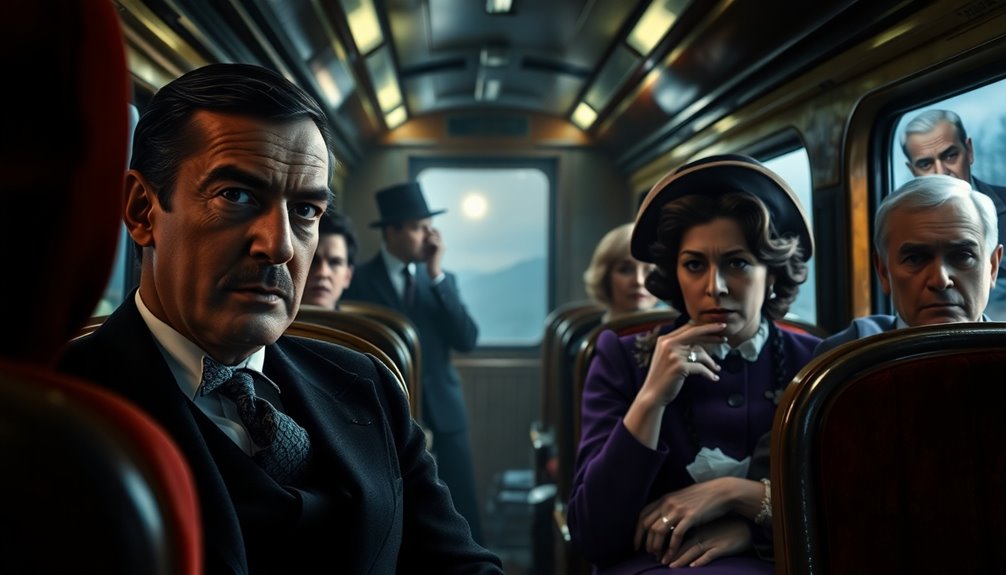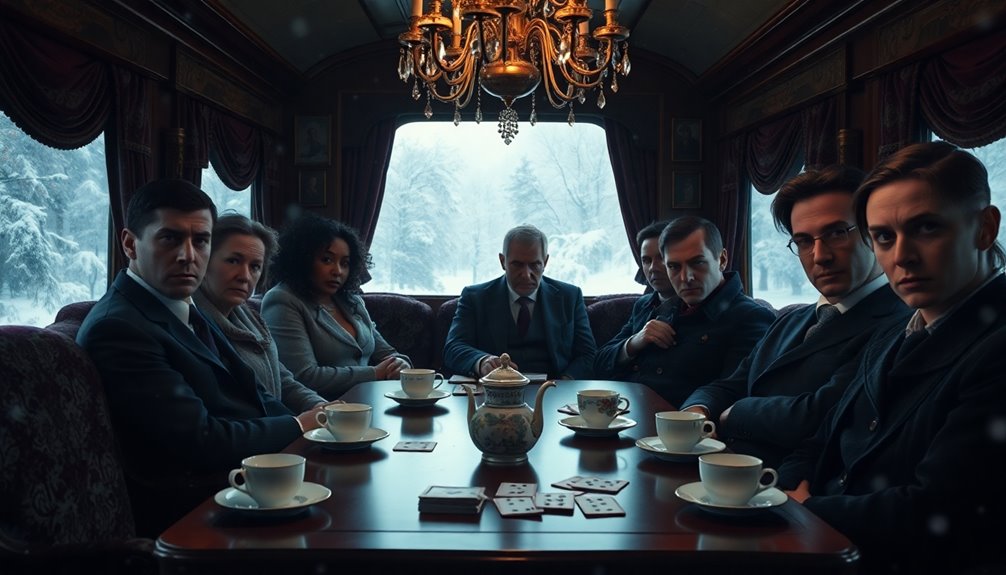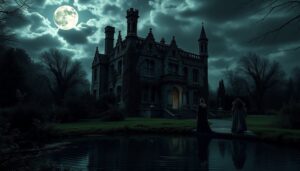*Murder on the Orient Express* is a classic whodunit that immerses you in a web of suspense and mystery. Agatha Christie crafts intricate plots filled with red herrings and moral dilemmas, keeping you guessing until the end. You're introduced to the brilliant detective Hercule Poirot, who navigates betrayal and justice among a colorful cast of characters. The confined setting of the train enhances the story's tension, making each revelation even more gripping. As you explore the themes of loyalty and revenge, you'll discover why this tale has captivated audiences for decades and what lies beneath its polished surface.
Agatha Christie's Enduring Legacy

Although Agatha Christie published *Murder on the Orient Express* in 1934, her legacy continues to thrive, enchanting readers even today.
Agatha Christie's influence on the mystery genre is undeniable. With 66 crime novels, 6 non-crime novels, and 150 short stories, she remains the most translated writer in the world. Her iconic detective, Hercule Poirot, captivates audiences and stands as a symbol of her ingenuity. Christie's works have sold over 100 million copies globally, highlighting her impact on literature. The intricate themes of betrayal and revenge in her stories echo the complexities found in other classic literary works, such as *Rebecca*.
Christie was honored as a Dame of the British Empire in 1971, cementing her status in literary history.
*Murder on the Orient Express* is celebrated for its intricate plot and compelling characters, ensuring that Agatha Christie's works remain essential reading for mystery lovers. The themes of betrayal and revenge are masterfully woven throughout her narratives, adding to their enduring appeal.
You'll find her stories continue to resonate, inspiring new generations of fans.
The Whodunit Genre Defined
The whodunit genre captivates readers with its clever blend of mystery and intrigue. At its core, a whodunit revolves around a mysterious crime, often featuring a detective who pieces together clues to identify the culprit hidden among a select group of suspects.
Classic elements, like those found in Agatha Christie's *Murder on the Orient Express*, showcase intricate plotting and confined settings that heighten suspense. You'll often encounter red herrings and misdirection, challenging you to solve the mystery alongside the detective. The genre often draws inspiration from historical settings, as seen in novels like The Lost Apothecary, which intertwine past and present narratives. The exploration of systemic oppression within narratives can enhance the weight of the mystery and the stakes involved.
The genre thrives on character depth and the intellectual challenge it presents, evolving over time yet remaining popular. Ultimately, whodunits invite you to engage in a thrilling game of deduction, making every twist and turn all the more exciting. Additionally, themes of loyalty and betrayal are often woven into the narrative, enriching the complexity of character relationships and motivations.
The Art of Adaptation

When adapting a beloved classic like Agatha Christie's *Murder on the Orient Express*, filmmakers face the challenge of honoring the original while making it relevant for today's audiences.
Kenneth Branagh's adaptation navigates this delicate balance by focusing on emotional depth, enriching character portrayals. He collaborates with the cast, allowing for real-time adjustments that enhance the character-driven narrative. This collaborative approach reflects the importance of creative expression in storytelling, which can serve as a powerful tool for engaging audiences. Additionally, the film's focus on character growth resonates with themes of resilience amid adversity, showcasing how individuals can evolve through challenging circumstances.
By blending humor with serious themes such as grief and revenge, the film resonates with contemporary viewers while retaining the charm of the original murder mystery.
Utilizing cinematic techniques like shooting on 65mm film, Branagh creates an immersive experience that supports the storytelling.
Previous adaptations struggled with this balance, but Branagh's approach successfully breathes new life into Christie's classic tale. Additionally, the film's exploration of resilience in overcoming adversity mirrors the powerful themes found in stories of survival and hope.
Kenneth Branagh's Directorial Vision
Branagh's directorial vision for *Murder on the Orient Express* showcases his commitment to infusing the classic story with emotional complexity and visual flair. By directing and starring as Hercule Poirot, he aimed to modernize the narrative while staying true to Agatha Christie's essence.
His focus on stunning visuals, elaborate sets, and intricate costumes highlights his attention to detail. However, some critics argue that his self-indulgent style prioritized his performance over the ensemble cast, leading to uneven character development. This mirrors the disintegration of the American Dream in literature, where individual aspirations often clash with societal expectations. Furthermore, the portrayal of gender roles in the film reflects how societal norms can impact character dynamics and interactions.
The use of flashy techniques, such as overhead shots and CGI train exteriors, often distracted from the story's core, raising questions about narrative coherence. Despite mixed reviews, Branagh's vision undeniably brought a unique aesthetic to *Murder on the Orient* and reflects the importance of character relationships in driving the plot forward.
Notable Characters and Their Arcs

In "Murder on the Orient Express," you'll witness Hercule Poirot's brilliant methods as he untangles the intricate lies woven by the passengers. The atmosphere of the train, reminiscent of the haunting ambiance of the Palais Garnier, heightens the tension as secrets unfold. You'll also uncover Princess Dragomiroff's secrets, revealing her deep connections to the victim and her strong sense of justice. Colonel Arbuthnot's loyalty adds another layer, as he wrestles with his protective instincts toward Countess Andrenyi amidst the chaos. The story's exploration of co-dependent relationships highlights how loyalty can sometimes lead to moral dilemmas and complicate the pursuit of justice. This intricate web of characters and their motivations reflects the themes of rivalry and ambition that are prevalent in classic literature.
Hercule Poirot's Methods
Often, Hercule Poirot's methods reveal the depths of human nature as he navigates the tangled web of motives surrounding the murder on the Orient Express.
Poirot must use keen observation and psychological insight, analyzing body language and subtle cues to unearth hidden truths among the suspects. His fastidious nature, while charming, can also complicate his investigations, showcasing his dramatic flair.
Interactions with M. Bouc and Mrs. Hubbard expose layers of deception that deepen the narrative intrigue. As he untangles each character's backstory, including Ratchett's dangerous past, Poirot encounters moral ambiguity that complicates his pursuit of truth.
Ultimately, his final reveal ties together these complex motives, illustrating Agatha Christie's masterful plot construction and Poirot's effective deductive methods.
Princess Dragomiroff's Secrets
While you explore the intricate web of relationships on the Orient Express, Princess Dragomiroff stands out as a character shrouded in mystery and authority. Wealthy and aristocratic, she becomes a key suspect in the murder investigation.
Her close ties to the victim, Ratchett, complicate her motives, revealing intricate layers of deception and unexpected loyalty. As you investigate deeper, you see her strong-willed personality, embodying both vulnerability and resilience amidst suspicion.
Each revelation about Princess Dragomiroff adds complexity to her arc, showcasing Agatha Christie's talent for crafting multidimensional characters. Ultimately, her involvement in the murder plot uncovers surprising depths, making her a compelling figure whose secrets intertwine with the fate of everyone aboard the train.
Colonel Arbuthnot's Loyalty
Princess Dragomiroff's intricate secrets set the stage for the complex dynamics aboard the Orient Express, particularly through the lens of Colonel Arbuthnot's loyalty.
As you explore the story, you see Arbuthnot's unwavering commitment, especially to Mary Debenham. His military background shapes his sense of honor and duty, guiding his actions amid the chaos of the murder mystery.
Throughout the narrative, his loyalty faces challenges as he grapples with the moral intricacies of the case. Ultimately, he aligns with Poirot's pursuit of justice, showcasing the tension between personal allegiance and the quest for truth.
Arbuthnot's steadfastness and protective nature enrich the themes of loyalty and betrayal, making him an essential character in this riveting tale on the Orient Express.
Cinematic Techniques in Storytelling
In *Murder on the Orient Express*, the visual aesthetics draw you into a richly detailed world, enhancing the film's atmosphere.
As you watch, overhead shots and tracking techniques create a unique character perspective, allowing you to feel the tension and urgency of the snowbound train.
However, you might find that while the visuals impress, they sometimes overshadow the narrative's depth.
Visual Aesthetics and Atmosphere
As you immerse yourself in the film adaptation of *Murder on the Orient Express*, the visual aesthetics immediately draw you into the opulent world of the 1930s.
Shot in 65mm format, the film enhances visual detail with sharper images and vibrant colors that showcase the train's luxurious atmosphere. Kenneth Branagh's use of CGI for exterior train shots aims to amplify the snowbound tension, though some critics see it as unnecessary.
The stunning sets and elaborate costumes are meticulously crafted, reflecting the lavishness of the original journey. While Branagh's overhead shots and tracking create a dynamic experience, they occasionally distract from the narrative.
Ultimately, *Murder on the Orient Express* demonstrates how striking visuals must pair with cohesive storytelling to resonate effectively.
Character Perspective and Engagement
While the film's stunning visuals captivate you, it's the character perspectives that truly drive engagement and emotional depth. You witness intricate character dynamics through carefully crafted visual storytelling techniques.
Here are three key elements that enhance your experience:
- Body Language: Subtle cues reveal characters' motives and emotions, allowing you to connect with their struggles.
- Overhead Shots: These flashy techniques create a sense of entrapment, amplifying the tension aboard the snowbound train.
- Tracking Shots: As the camera moves, you feel the urgency and chaos, drawing you deeper into the narrative.
Despite these efforts, the pacing can falter, sometimes leaving you craving more emotional investment in the characters.
Still, their interactions keep you engaged throughout the mystery.
Cultural Impact of the Story

*Murder on the Orient Express* has left an indelible mark on popular culture, enthralling audiences through its myriad adaptations in film, television, and theater.
You've likely noticed how the story, featuring the iconic detective Poirot, continues to inspire creativity and discussion. Its luxurious setting on the Orient Express train has sparked a surge in literary tourism, with fans visiting the Pera Palace Hotel's Room 411 to connect with the tale.
Additionally, Agatha Christie's work has fostered the formation of clubs and societies dedicated to exploring her mysteries. The themes of justice and moral complexity resonate deeply, showing Christie's ability to provoke thought about human nature while maintaining relevance for contemporary readers.
The cultural impact of this classic whodunit is undeniable.
Comparing Film Adaptations
When you compare the film adaptations of *Murder on the Orient Express*, you'll notice a significant shift in quality and character development.
The earlier versions, like the 1974 classic, offer a richer narrative and deeper characters than the more recent adaptations.
Examining these differences reveals how the essence of Agatha Christie's story has evolved on screen.
Adaptation Quality Comparison
As filmmakers adapt Agatha Christie's *Murder on the Orient Express*, they often face the challenge of balancing visual flair with the intricate storytelling that defines the original novel.
In the adaptation quality comparison, you'll notice distinct differences among interpretations of detective Hercule Poirot:
- The 2001 TV movie struggled with elegance and altered key plot elements, leading to mixed reviews.
- Kenneth Branagh's 2017 film prioritized his portrayal of Poirot, sidelining the ensemble cast and sacrificing character depth.
- While using modern techniques like CGI for exterior shots, critics felt it detracted from the narrative's richness.
Ultimately, each adaptation grapples with capturing the suspense and character nuances that made Christie's work a classic.
Character Development Analysis
Character depth is essential in adaptations of Agatha Christie's *Murder on the Orient Express*, yet filmmakers often struggle to bring this richness to life.
In Kenneth Branagh's 2017 version, despite a star-studded cast, critics argue the character development lacks depth, wasting the ensemble's potential. The 2001 TV adaptation's modern twists, like laptops, dilute the original essence, altering character dynamics.
In contrast, the 1974 film shines with strong performances by Ingrid Bergman and Sean Connery, effectively capturing the intricate relationships that enhance the mystery.
Additionally, while Branagh's Poirot leans toward self-indulgence, previous portrayals, like David Suchet's, emphasize psychological insight, showcasing the nuanced interplay that Christie's writing so vividly presents.
Adapting this complexity remains a challenge for filmmakers.
Audience Reception and Critiques

Despite the allure of Agatha Christie's classic mystery, audience reception of various adaptations, particularly Kenneth Branagh's 2017 film, has often fallen short of expectations.
Many viewers hoped for a gripping classic whodunit, but they were left wanting. Here are three common critiques:
- Branagh's self-indulgent direction overshadowed the ensemble cast, limiting character development.
- The 2001 TV movie adaptation lacked the elegance and style of previous versions, leading to mixed reviews.
- Critics noted that flashy techniques in Branagh's adaptation detracted from the narrative's substance, resulting in poor pacing and execution.
Themes of Justice and Morality
Justice and morality intertwine intricately in *Murder on the Orient Express*, prompting you to ponder the true nature of right and wrong. As Hercule Poirot investigates, he confronts the moral implications of each character's backstory, revealing personal vendettas that complicate the pursuit of justice.
You'll notice that the twist ending presents two potential solutions, emphasizing the subjective nature of justice and raising ethical questions about vigilantism versus legal justice.
Christie skillfully contrasts societal laws with personal morals, showcasing how each character's choices reflect their beliefs about right and wrong. Through Poirot's journey, the story critiques the legal system's rigidity, suggesting that sometimes, achieving a greater good may require stepping outside the law's confines.
The Role of Poirot

In unraveling the complex themes of justice and morality, Hercule Poirot emerges as a pivotal figure whose methods and mindset challenge conventional notions of right and wrong.
His meticulous nature and keen psychological insights allow you to see the world of crime through his eyes.
Poirot's role in *Murder on the Orient Express* highlights three essential traits:
- Meticulous Observation: He notices subtle details that others overlook.
- Emotional Insight: Poirot understands human behavior, adding depth to his investigations.
- Challenging Morality: His approach forces you to question what justice truly means.
As he navigates the intricacies of the case, Poirot invites you to engage with the moral dilemmas, transforming the narrative into a profound exploration of right and wrong.
The Timeless Appeal of Mystery
As readers plunge into Agatha Christie's *Murder on the Orient Express*, they're drawn into a world where every clue holds the promise of revelation.
This mystery genre, exemplified by Christie's work, captivates you, showcasing intricate plots that keep you guessing until the last moment.
With over 2 billion books sold, Christie's engaging characters and suspenseful storytelling have solidified her as the most translated writer in history.
The enduring popularity of *Murder on the Orient Express* highlights its timeless appeal, resonating with both historical and contemporary audiences.
Literary adaptations and dedicated clubs further spark your interest in solving whodunits.
The Orient Express itself symbolizes adventure, enhancing the allure of Christie's narrative and inviting you to explore its rich tapestry of intrigue.
Conclusion
You might think classic mysteries are outdated, but "Murder on the Orient Express" proves otherwise. Agatha Christie's intricate plot and unforgettable characters still captivate today's audience. Kenneth Branagh's fresh take breathes new life into the story, making it accessible and engaging for everyone. As you journey through themes of justice and morality, you'll find that the thrill of solving a whodunit never fades. So, immerse yourself and let the mystery unfold—you won't regret it!



